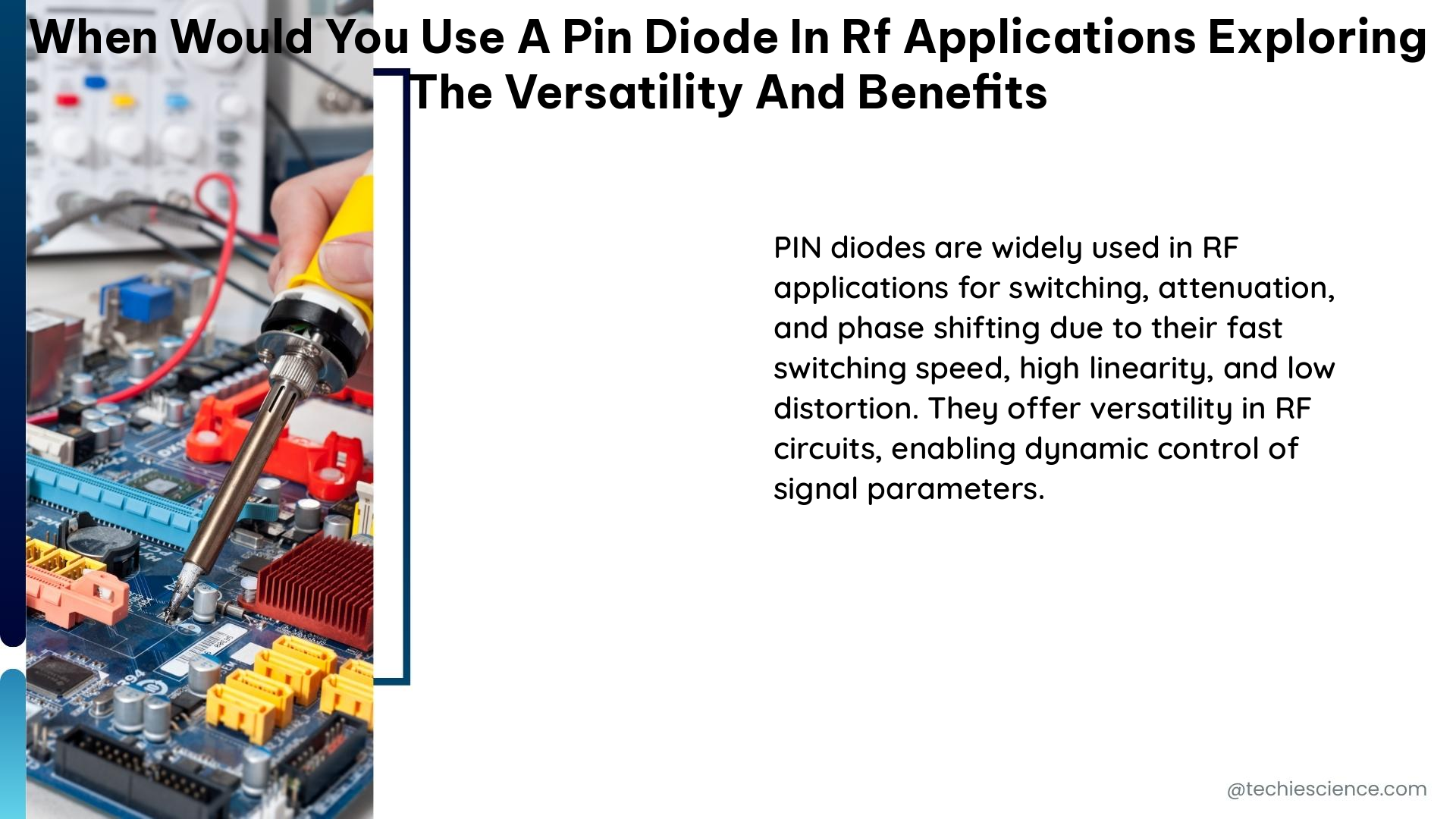PIN diodes are a crucial component in the world of radio frequency (RF) electronics, offering a unique set of characteristics that make them indispensable in a wide range of applications. From high-power switching and attenuation to phase shifting and signal modulation, PIN diodes have become a staple in the arsenal of RF engineers and designers. In this comprehensive guide, we will delve into the specific scenarios where the use of PIN diodes is most beneficial, exploring their versatility and the advantages they bring to the table.
Controlling Large Amounts of RF Power with Lower Levels of DC
One of the primary advantages of PIN diodes in RF applications is their ability to handle high levels of RF power while requiring significantly less DC power for control. This is due to the unique structure of PIN diodes, which essentially behave as current-controlled resistors at radio and microwave frequencies.
At zero or reverse bias, a PIN diode exhibits a high resistance, effectively blocking the flow of RF signals. However, when a forward bias current is applied, the resistance of the diode decreases, allowing the RF signal to pass through with minimal attenuation. This current-controlled resistance characteristic enables efficient power management, making PIN diodes ideal for applications such as:
- High-Power RF Switches: PIN diodes can be used to switch high-power RF signals, with the ability to handle up to several kilowatts of power while requiring only a few milliamps of DC control current.
- Attenuators and Variable Gain Amplifiers: By varying the bias current, the resistance of a PIN diode can be adjusted, allowing for the implementation of variable attenuators and gain control circuits.
- Modulators and Phase Shifters: The adjustable resistance of PIN diodes can be leveraged to create modulation and phase shifting circuits, enabling advanced signal processing techniques.
Adjustable Resistance and Linearity

The ability to adjust the resistance of a PIN diode is a key feature that makes them invaluable in RF applications. By varying the bias current, the resistance of a PIN diode can be precisely controlled, allowing for the implementation of various circuit topologies.
One of the critical advantages of this adjustable resistance is the excellent linearity that PIN diodes exhibit. This linearity is crucial in high-frequency and high-power applications, as it ensures minimal distortion and signal loss. This makes PIN diodes ideal for:
- RF Switching: The linear response of PIN diodes allows for clean and efficient switching of RF signals, with minimal introduction of harmonics or intermodulation distortion.
- Signal Processing: The linear resistance control of PIN diodes enables the implementation of high-performance signal processing circuits, such as variable attenuators, modulators, and phase shifters.
High-Frequency Performance and Low Capacitance
PIN diodes are designed to operate at very high frequencies, with some models capable of handling frequencies up to 40 GHz or even higher. This makes them suitable for use in microwave and millimeter-wave applications, where the demand for high-frequency performance is paramount.
In addition to their high-frequency capabilities, PIN diodes also exhibit low capacitance at zero or reverse bias. This low capacitance is beneficial for RF applications where low insertion loss and high isolation are required, such as:
- RF Switches: The low capacitance of PIN diodes allows for the implementation of high-isolation RF switches, which are essential in applications like antenna switching, signal routing, and test equipment.
- Matching Networks: The low capacitance of PIN diodes can be leveraged in the design of tunable matching networks, enabling efficient power transfer and impedance matching in RF circuits.
Thermal Considerations and Carrier Lifetime
While the versatility and performance of PIN diodes make them highly desirable in RF applications, it is essential to consider their thermal characteristics and carrier lifetime when designing circuits.
PIN diodes have a maximum average power dissipation (PD) and a maximum peak power dissipation (PP) rating, which must be taken into account to ensure reliable operation and prevent overheating. Proper thermal management, such as the use of heat sinks or other cooling techniques, is crucial to maintain the diode’s performance and longevity.
Additionally, the carrier lifetime (τ) of a PIN diode affects its lowest frequency of operation and the distortion it produces. By carefully choosing the nominal impedance and diode geometry, it is possible to optimize PIN diode performance for specific RF applications, ensuring optimal signal quality and minimizing unwanted effects.
Conclusion
PIN diodes are a versatile and indispensable component in the world of RF electronics, offering a unique set of characteristics that make them invaluable in a wide range of applications. From high-power switching and attenuation to phase shifting and signal modulation, PIN diodes have become a staple in the arsenal of RF engineers and designers.
By understanding the key parameters and specifications of PIN diodes, electronics students and professionals can effectively incorporate them into their RF circuit designs, leveraging their adjustable resistance, high-frequency performance, low capacitance, and linear response to achieve optimal performance and efficiency.
Reference Links:
- Design With PIN Diodes – Skyworks
- Basics of PIN diodes and their use in RF switch applications – YouTube
- How and Why to Use PIN Diodes for RF Switching – DigiKey

The lambdageeks.com Core SME Team is a group of experienced subject matter experts from diverse scientific and technical fields including Physics, Chemistry, Technology,Electronics & Electrical Engineering, Automotive, Mechanical Engineering. Our team collaborates to create high-quality, well-researched articles on a wide range of science and technology topics for the lambdageeks.com website.
All Our Senior SME are having more than 7 Years of experience in the respective fields . They are either Working Industry Professionals or assocaited With different Universities. Refer Our Authors Page to get to know About our Core SMEs.